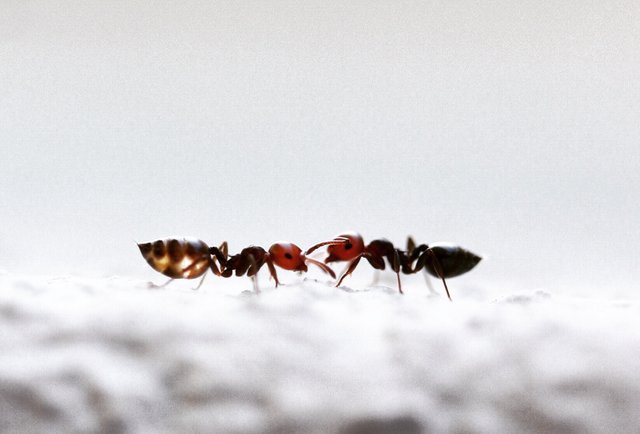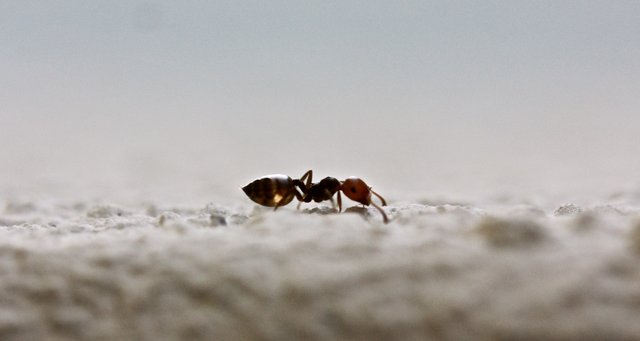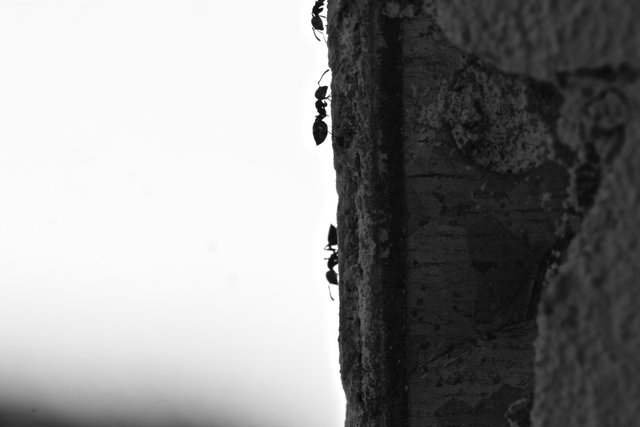Ants’ meeting - Chronicles of a spring day [ENG/ITA]
 |  |
|---|
After winter, after all those gray and cold days, a time of year comes when nature awakens from its dormant state and spring begins to be felt. It is in those days that we begin to spend more and more time in the garden, feeling the buzz of pollinating insects that frantically compete for pollen research. Walking in the meadow in an area of sunshine you start to hear the rustling of lizards that quickly move away and the birds that sing in cheerful signals alternating. In short, a world full of sounds and scents. However, looking in the corners and on the walls, long rows of organisms appear that do not need to make noise to warn of their presence: ants.
Dopo l'inverno, dopo tutti quei giorni grigi e freddi, arriva un periodo dell'anno in cui la natura si risveglia dal suo stato dormiente e la primavera inizia a farsi sentire. È in quei giorni che iniziamo a trascorrere sempre più tempo in giardino, sentendo il ronzio degli insetti impollinatori che competono freneticamente per la ricerca del polline. Camminando nel prato in una zona di sole si inizia a sentire il fruscio delle lucertole che si allontanano rapidamente e gli uccelli che cantano in segnali allegri si alternano. Insomma, un mondo pieno di suoni e profumi. Tuttavia, guardando negli angoli e sui muri, appaiono lunghe file di organismi che non hanno bisogno di fare rumore per avvertire della loro presenza: le formiche.

ORIGINAL WORK BY SPAGHETTISCIENCE
If you need this or other images, just ask!
It is always very curious to observe the dynamics of these fascinating creatures, on the day these photos were taken, I had to follow their wake around the whole house. It was even more curious to understand that in reality the trail was composed of two antiparallel rows and each time two ants crossed, they stopped for a moment, touched each other with their antennas and continued on their way.
È sempre molto curioso osservare le dinamiche di queste affascinanti creature, il giorno in cui sono state scattate queste foto ho dovuto seguire la loro scia attorno a tutta la casa. È stato ancora più curioso capire che in realtà la pista era composta da due file antiparallele e ogni volta che due formiche si incrociavano si fermavano per un momento, si toccavano con le loro antenne, e proseguivano per la loro strada.

ORIGINAL WORK BY SPAGHETTISCIENCE
If you need this or other images, just ask!
The scientific name of the species to which these ants belong is Crematogaster scutellaris, known in Italy with two different names one of which, very friendly, is "rizzaculo" which brutally translated would be "ass raiser", because of position that assumes in defense mode, in which it folds forward the abdomen threatening the opponent with its sting (although it is of modest size). This species of ant belongs to the subfamily Myrmicinae, it widespreads in the countries of the Mediterranean area, as well as in Germany and Netherlands where it was introduced due to the trade in wood (the substrate preferably used for nesting of this species).
Il nome scientifico della specie a cui appartengono queste formiche è Crematogaster scutellaris, noto in Italia con due nomi diversi uno dei quali, molto amichevole, è "rizzaculo" a causa della posizione che assume in modalità di difesa, nella quale piega in avanti l'addome minacciando l'avversario con il suo pungiglione (sebbene sia di dimensioni modeste). Questa specie di formica appartiene alla sottofamiglia Myrmicinae, è ampiamente presente nei paesi dell'area del Mediterraneo, così come in Germania e nei Paesi Bassi dove è stata introdotta a causa del commercio del legno (il substrato preferibilmente utilizzato per la nidificazione di questa specie).

ORIGINAL WORK BY SPAGHETTISCIENCE
If you need this or other images, just ask!
A very interesting thing about ants is their scrupulous ability to maintain an orderly row (which is often difficult even for humans). The reason is to be found in their communication strategies. Ants, like other insects, perceive olfactory signals, sent by other workers, through thin antennas. In this way, a trail of pheromone that leads to food translates into a track carefully followed. In the same way, when two ants meet, they touch each other with the antennas just to exchange olfactory messages, it is a simple recognition mechanism. But the use of pheromone by ants also serves other purposes. For example, a crushed ant emits an alarm pheromone that is able to alert all the ants that are nearby creating moments of frenzy.
Una cosa molto interessante delle formiche è la loro scrupolosa capacità di mantenere una fila ordinata (cosa spesso difficile addirittura per gli umani) e il motivo è da ricercare nelle loro strategie di comunicazione. Le formiche, come altri insetti, percepiscono segnali olfattivi inviati da altri lavoratori attraverso le antenne sottili. In questo modo, una scia di feromoni che porta al cibo si traduce in una traccia che viene seguita con cura. Allo stesso modo, quando due formiche si incontrano, si toccano con le antenne solo per scambiarsi messaggi olfattivi, è un semplice meccanismo di riconoscimento. Ma l'uso del feromone da parte delle formiche si verifica anche in altre situazioni, per esempio, quando una formica viene schiacciata, l’allerta a tutte le formiche presenti nelle vicinanze viene data tramite l’emissione di feromoni di allarme.

ORIGINAL WORK BY SPAGHETTISCIENCE
If you need this or other images, just ask!
CURIOSITY
The evolutionary paradox of sterile castes
A very interesting aspect of ants and, in general, of almost all social insects, is an enormous apparent paradox. The evolutionary paradox of sterile castes was first emphasized by Charles Darwin in his masterpiece "The Origin of Species". How can a group of individuals not reproduce throughout their lives and still have an evolutionary advantage? What advantage can a worker ant have in working from the first to the last day of her life, excluding the possibility of transmitting her own genes? To give an answer to this question we must think in terms of pieces. Let's start with the basics: we usually think that reproductive success is measured only in a vertical line, or in terms of genetic heritage that is transmitted from parents to their children. In this way we have a certain kinship value with our parents and the other way around. But, in terms of genetic, we also must consider an additive kinship because, if we think about counting the quantity of genes in common, there are also these in the case of brothers and sisters. Precisely, in Homo sapiens there is the same value of kinship both between parents and children and between brothers, and it is 1/2. In this case, there is no difference between the advantage coming from reproduction or brotherhood in terms of genetic heritage. Now, what would you think if I told you that, if you were an ant, you would be more genetically related to your sister than to a hypothetical progeny? That's exactly what happens in ants. The different genetic make-up between males and females (diploid females and haploid males) confuses kinship relationships so that the sisters are much more related to each other than to their daughters. In this way, reasoning in terms of the genetic heritage that is handed down (even through the sisters), it is more convenient for a worker to work to help the queen generate other sisters, rather than reproduce themselves. This is why even worker ants, which apparently have no evolutionary advantage, have the ability to pass on their genes without mating, deceiving the evolutionary paradox proposed by Darwin.
CURIOSITÀ
Il paradosso evolutivo delle caste sterili
Un aspetto molto interessante delle formiche e, in generale, di quasi tutti gli insetti sociali, è un enorme e, allo stesso tempo, apparente paradosso. Il paradosso evolutivo delle caste sterili è stato sottolineato per la prima volta da Charles Darwin nel suo capolavoro "L'origine delle specie". Come può un gruppo di individui non riprodursi per tutta la vita e avere comunque un vantaggio evolutivo? Quale vantaggio può avere una formica operaia nel lavorare dal primo all'ultimo giorno della sua vita, escludendo la possibilità di trasmettere i propri geni? Per dare una risposta a questa domanda dobbiamo pensare per gradi. Partiamo dalle basi: solitamente immaginiamo il successo riproduttivo come una misura in linea verticale, in termini di patrimonio genetico che viene trasmesso dai genitori ai figli. In questo modo abbiamo un certo valore di parentela con i nostri genitori e viceversa. Ma, in termini genetici, dobbiamo anche considerare una parentela additiva perché, se pensiamo di contare la quantità di geni in comune, non possiamo ignorare la porzione esistente nel caso di fratelli e sorelle. Precisamente, nell'Homo sapiens esiste lo stesso valore di parentela sia tra genitori e figli che tra fratelli (ed è, precisamente, ½). In questo caso, ragionando secondo la quantità di geni in comune, non vi è alcuna differenza tra il vantaggio derivante dalla riproduzione o dalla fratellanza. Ora, cosa penseresti se ti dicessi che, se tu fossi una formica, saresti geneticamente più imparentato a tua sorella che a un'ipotetica progenie? Questo è esattamente ciò che accade nelle formiche. La diversa composizione genetica tra maschi e femmine (femmine diploidi e maschi aploidi) confonde le relazioni di parentela in modo che le sorelle siano molto più imparentate tra di loro rispetto alle loro figlie. In questo modo, secondo l’eredità genetica tramandata (anche attraverso le sorelle), è più conveniente per una formica operaia lavorare per aiutare la regina a generare altre sorelle, piuttosto che riprodursi a loro volta. Ecco perché anche le formiche operaie, che apparentemente non hanno alcun vantaggio evolutivo, hanno la capacità di trasmettere i loro geni senza accoppiarsi, raggirando il paradosso evolutivo proposto da Darwin.
References

Beautifully put together article with original photos! I remember I loved watching ants very much when I was a child, and their behaviours are fascinating, indeed <3
I enjoyed how informative and well written this post is <3 Really lovely photos, too <3 <3 <3
Thank you so much! You hit the point, we really like to combine two of our passions, photography and scientific explanations, because they are our daily bread, often it is thanks to our little knowledge that we can identify what to photograph and we really like to share these experiences with others :):):)
This post was selected, voted and shared by the discovery-it curation team in collaboration with the C-Squared Curation Collective. You can use the #Discovery-it tag to make your posts easy to find in the eyes of the curator. We also encourage you to vote @c-squared as a witness to support this project.
This post has been voted on by the SteemSTEM curation team and voting trail. It is elligible for support from @curie and @utopian-io.
If you appreciate the work we are doing, then consider supporting our witness stem.witness. Additional witness support to the curie witness and utopian-io witness would be appreciated as well.
For additional information please join us on the SteemSTEM discord and to get to know the rest of the community!
Please consider setting @steemstem as a beneficiary to your post to get a stronger support.
Please consider using the steemstem.io app to get a stronger support.
Hi @spaghettiscience!
Your post was upvoted by Utopian.io in cooperation with @steemstem - supporting knowledge, innovation and technological advancement on the Steem Blockchain.
Contribute to Open Source with utopian.io
Learn how to contribute on our website and join the new open source economy.
Want to chat? Join the Utopian Community on Discord https://discord.gg/h52nFrV
Congratulations @spaghettiscience! You have completed the following achievement on the Steem blockchain and have been rewarded with new badge(s) :
You can view your badges on your Steem Board and compare to others on the Steem Ranking
If you no longer want to receive notifications, reply to this comment with the word
STOPVote for @Steemitboard as a witness to get one more award and increased upvotes!